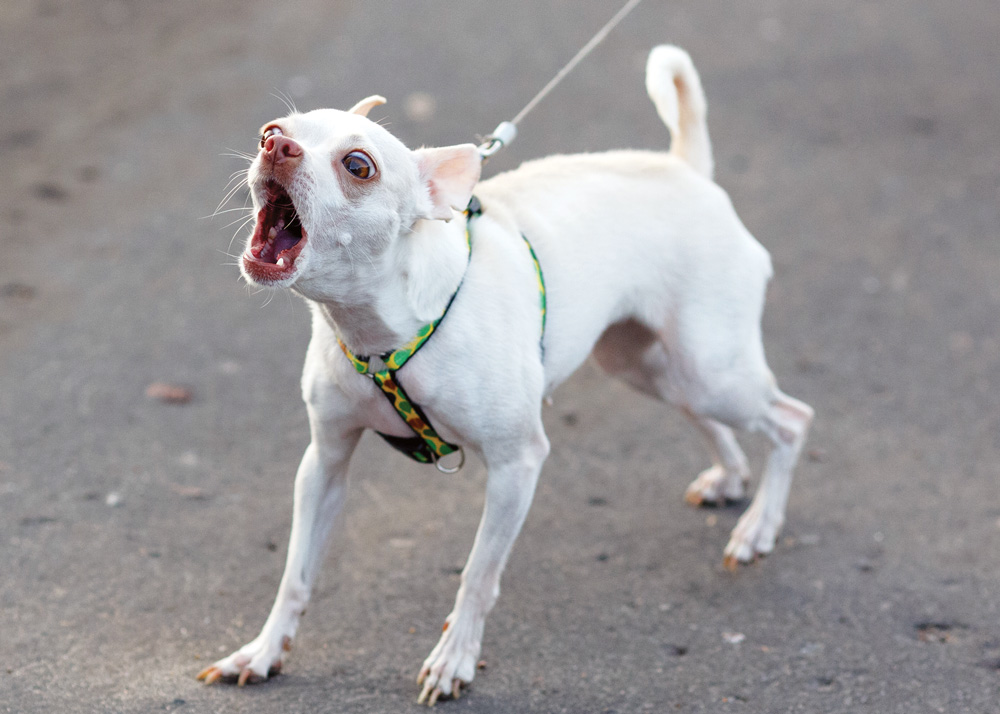

Is My Dog Aggressive? Or Fearful?
Reactivity vs. Aggression
Most of us would agree on the general definition of “aggression.” But when it comes to dog behaviour, the term can mean different things to different people. For example, Melissa describes her German Shepherd Bailey as aggressive. She bases her assessment on the fact that when he passes other dogs on walks, he lunges and barks at them. Justin too believes that his dog is aggressive. When people reach out to pet Milo the Shih Tzu, he sometimes snaps at their hands. Are Bailey and Milo truly aggressive? It’s possible, but chances are much greater that what the dogs are displaying is actually fear-based reactivity. Of course, there are truly aggressive dogs out there, but the vast majority of what owners typically call aggression is not actually an intent to cause harm, but a reaction to something that is scaring the dog or making him uncomfortable.
Confusing reactivity with aggression is very common. Reactive dogs overreact to certain stimuli or situations, usually because they are fearful. Genetics, lack of socialization, lack of training/self-control, and/or a frightening experience, can all cause reactivity. And though reactivity is different than aggression, it can escalate.
Photo Volodymyr P/bigstock.com
Adolescence is the developmental phase during which many pups begin to gain confidence. A dog who previously fled when encountering something frightening him may now take the offence. He learns that barking, growling, or lunging results in the big, scary thing—whether another dog or a person—moving away quickly. A dog who barks at other dogs on walks is rewarded by the other dog moving away, even though the distancing is really the product of simply passing each other. A dog who fears a hand approaching overhead may air-snap, causing the person to quickly draw the hand. These consequences are rewarding, and so the behaviour is repeated.
It can be difficult to distinguish fear-based reactivity from true aggression, especially in cases where an owner believes their dog is guarding them. I’ve had clients who have told me their four-footed bodyguard wouldn’t let anyone get close, only to discover that the dog was essentially protecting himself from strangers. It’s easy to understand how a dog who lunges while standing in front of his owner could be mistaken for a dog who is displaying guarding behaviour, but again, so often what seems like aggression is actual fear-based reactivity.
“Leash-reactive dogs often growl, bark or lunge toward things that make them nervous or fearful in an attempt to make the scary thing go away. Their triggers may be other dogs or people.”
So, how can you tell the difference? Just ask the dog. No, I’m not suggesting you inquire, “How do you really feel about that Jack Russell?” I mean that you can learn an awful lot just by observing canine body language. The next time your dog becomes reactive, look at his overall body posture. Is his weight more heavily distributed forward or backward? Or does he stand without leaning in either direction? A confident dog’s body weight is typically well balanced. If the dog is truly aggressive, the body weight will be forward. Of course, there are other reasons a dog’s body weight might be forward as well, including excitedly pulling toward something. The body weight of a dog who is fearful will be more heavily distributed toward the rear.
A fearful dog’s ears will also be positioned further back. While a dog who is truly fearful will likely have his ears laid flat against his head, there are gradations. The ears may be only held slightly back, and sometimes only one ear is titled backward with concern. The ears of a confident or aggressive dog will have a definite forward point. Just as with body weight, there are other possible reasons for ear position. Forward ears could also connote interest or focus, while laid-back ears could indicate submission, for example. Ear positioning is easier to observe in dogs with pricked ears as opposed to floppy ones. For flop-eared dogs, looking at the base of the ear can be helpful in assessing position.
Photo otsphoto/shutterstock.com
The tail is another revealing part of the body language puzzle. A dog who is fearful will hold his tail in a low position; a truly frightened dog may even tuck it under his body completely. A nervous dog may hold the tail low while wagging in a fast, tight arc. A confident dog will display a higher tail carriage, and a dog showing aggression will have a tail that is held high and may be wagging stiffly.
There are other parts of body language that should also be taken into account. The eyes may be the windows to the soul, but they are also the doorway to discovering how a dog is really feeling. A hard stare is a threat in the animal kingdom, and a dog who is staring with laser focus at another dog is not showing fear-based reactivity, but is presenting a challenge and possible danger. A dog who wants to avoid a threat will avert his eyes and possibly also turn his head and/or entire body away from that threat. Other signs of nervousness include lip licking, yawning, sniffing the ground, or the dog developing a sudden itch. No, the dog hasn’t suddenly developed fleas; biting at his own hindquarters or using a back leg to scratch along the side of the face serves to momentarily turn the dog away from the threat, thereby creating a break in the tension.
Photo Balakate/bigstock.com
Although observing body language is helpful, with fear-based reactivity there can be an element of emotional conflict. A dog might bark and sound for all the world as though he is going to attack another dog, while at the same time his ears and body weight are back. In fact, in my experience that combination is pretty classic. Many times I have seen dogs who have been described as aggressive toward people where the dog will lunge and then dart backward while at the same time barking, as though to say, “You big scary thing, don’t make me come over there!” What these poor dogs really want is for the big, scary thing to go away.
Each piece of body language must be assessed as part of the overall display and in the context of the situation in order to distinguish fear-based reactivity from true aggression. It is important to take the time to observe and come to the correct conclusion, especially because once a dog has been labeled as “aggressive,” people tend to see all of the dog’s behaviour through that lens. The dog might not get the proper rehabilitation he needs, or worse, he could end up rehomed or even euthanized. Understanding that a dog is displaying fear-based reactivity allows for the proper behaviour modification to take place, under the guidance of a professional trainer if necessary. If you believe your dog is truly aggressive, avoid his triggers and seek help from a professional.
Join the newsletter and never miss out on dog content again!
"*" indicates required fields
By clicking the arrow, you agree to our web Terms of Use and Privacy & Cookie Policy. Easy unsubscribe links are provided in every email.


